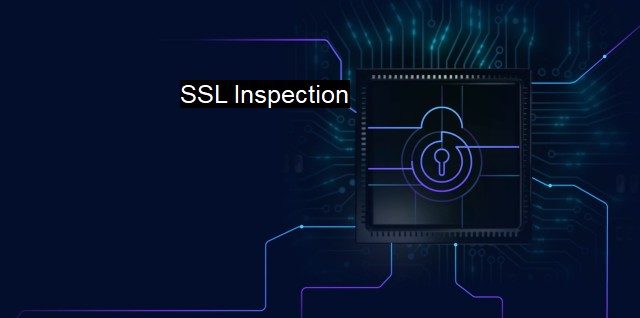What is SSL Inspection?
The Importance of SSL Inspection in Bridging the Security Gap: Understanding SSL Encryption, SSL Inspection and Balancing Regulatory Compliance with Security Operations.
SSL Inspection refers to the process used by network security solutions to decrypt, view, and re-encrypt SSL/TLS traffic. SSL/TLS is a cryptographic protocol designed to provide secure connections over a network (e.g., the internet) by encrypting the data transferred between different entities.Ensuring unlawfully encrypted data doesn't slide through is what SSL Inspection intends; it decrypts the encrypted data to allow the security systems to thoroughly examine the content, re-encrypting it before forwarding to the intended recipient. This becomes necessary particularly because a myriad of malicious activities such as cyber-attacks often hide within encrypted traffic.
The importance of SSL Inspection stems from the exponential growth of SSL-encrypted traffic over the years. SSL/TLS encryption has indeed fulfilled its purpose of ushering in an era of safer web transactions. Nonetheless, the paradox here is that such encryption can also act as a perfect cloak for cyber-attacks that antivirus software cannot detect, rendering systems vulnerable. This is where SSL Inspection proves crucial.
Several types of malware and viruses can hide in SSL/TLS encrypted channel, using it as a secret passage into networks while bypassing usual security protocols. SSL Inspection prevents this by opening the encrypted packets to verify their contents before letting them through, preventing disguised forms of attacks.
One may ask, shouldn't any network security solution perform the SSL Inspection? Unfortunately, it’s not that simple. While nearly all secure web gateways, next-generation firewalls, data loss prevention, and other network security solutions have SSL Inspection capabilities, issues relating to privacy, performance, and legality may restrict its effectiveness or prohibit its use entirely.
Regarding privacy, there are legitimate concerns about corporate and invasions of privacy since SSL Inspection requires decryption and inspection of content that may contain sensitive information. Similarly, real-time decryption, inspection, and encryption of SSL traffic translates into a significant computational burden that can affect network performance.
Legal issues surround the legality of SSL Inspection in certain contexts or regions, treading a thin line between necessary security and possible unauthorized surveillance. Therefore, organizations implementing SSL Inspection must conduct a stringent analysis of their legal backdrop, ensuring lawful activity.
Technical requirements for SSL Inspection differ based on the network security solution. Before it inspects anything, SSL encrypted traffic must be decrypted, a process that requires the private encryption key associated with an SSL certificate. Network security solutions routinely generate 'fake' temporary SSL certificates so they can decrypt traffic, inspect it, and re-encrypt it; these temporary certificates are often intertwined intricately with the device’s configurations.
Still, compliance and scope define the efficacy. SSL Inspection must be configured properly to effectively discern all suspicious internet activities, maintaining visibility over encrypted threats. Understanding what files to decrypt for inspection, legitimating user access, and abiding by laws in territories where data privacy might control visibility into encrypted threats—it’s a somewhat elusive blanket to cast.
Security solutions need to optimize functionality for SSL Inspection. They are integrated with pre-established configurations, intricate technologies and forge ahead with a policy-based program to streamline navigation between security and lawful accessibility.
SSL Inspection is a vital element of a well-rounded cybersecurity and antivirus arsenal, an inspector in a uniform that checks passers-by to ensure hostile entities don't lurk underneath the cloak of SSL/TLS encryption. Despite issues surrounding privacy, performance, and legality, appropriately-managed and contextualized SSL Inspection is a valuable tool in the global fight against cyber threats.

SSL Inspection FAQs
What is SSL inspection?
SSL inspection is a process of intercepting encrypted traffic, decrypting it, checking it for malicious content or policy violations, and then re-encrypting it before sending it to its destination.Why is SSL inspection important in cybersecurity and antivirus?
SSL inspection is essential for detecting and blocking threats hidden in encrypted traffic. Cybercriminals often use encryption to evade detection and infect systems with malware through SSL-encrypted websites or email attachments. SSL inspection helps antivirus and security solutions identify and block these threats before they reach their targets.What are the benefits of SSL inspection?
SSL inspection provides several benefits, including increased visibility into encrypted traffic, better threat detection and prevention of malware attacks, and improved data protection and compliance. SSL inspection also helps organizations to meet regulatory compliance requirements and prevent data leakage.Is SSL inspection legal and ethical?
SSL inspection is a controversial practice that raises privacy and security concerns. It involves intercepting and decrypting confidential communication, which can violate users' privacy and breach confidentiality agreements. However, in many cases, SSL inspection is legal and necessary for protecting networks and preventing cyber attacks. Organizations should disclose their SSL inspection policies to their users and ensure that they comply with applicable laws and regulations.| | A | | | B | | | C | | | D | | | E | | | F | | | G | | | H | | | I | | | J | | | K | | | L | | | M | |
| | N | | | O | | | P | | | Q | | | R | | | S | | | T | | | U | | | V | | | W | | | X | | | Y | | | Z | |
| | 1 | | | 2 | | | 3 | | | 4 | | | 7 | | | 8 | | |||||||